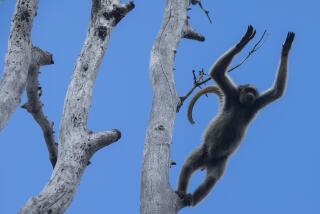Ancient primate is called a crucial evolutionary link
- Share via
A 55-million-year-old fossil of a mouse-sized primate has been identified as a crucial evolutionary link in the chain that led to apes and humans.
Four inches long, with a 5-inch tail and protruding eyes, Archicebus achilles probably thrived for millions of years during a warm period of Earth’s history, feasting on insects and leaping around in canopies of trees that surrounded a tropical lake in what now is China, according to a report published online Wednesday by the journal Nature.
“It was probably kind of a frenetic animal,” said study leader Chris Beard, a paleontologist at the Carnegie Museum of Natural History in Pittsburgh. “You could even think anxious — an animal that moves around a lot, very active, searching for its next meal, very agile in the trees, climbing and leaping around in the canopy.”
The remarkably complete fossil of Archicebus — derived from Latin and Greek for “ancient monkey” — helps make the case that primates first arose in Asia, even though the lineage leading to man later flourished and diversified in Africa.
“If we go along a tree to the point where all the primates began to evolve, they all point to Asia,” said paleontologist Xijun Ni of the Chinese Academy of Sciences, who led the fieldwork in a fossil-rich area of Hubei province that is better known for its spectacular fish fossils.
Richard Kay, a Duke University anthropologist who has studied early primate evolution, said A. achilles lies tantalizingly close to the first primate of the evolutionary tree.
“This specimen is not the earliest primate but very close to it, perhaps within a million years or so,” said Kay, who was not part of the study team. “This animal is the perfect model for what I think the basal primate was like.”
A distinctive heel bone was one of the characteristics A. achilles had in common with the branch of primates leading to apes, monkeys and people, inspiring the “achilles” moniker. The creature’s teeth were also similar to those of ancient marmosets, according to the Nature report.
Altogether, scientists compared about 1,000 characteristics across 157 primates, including lemurs, baboons, macaques, gorillas, chimpanzees and even Homo sapiens.
The analysis took 10 years and included scanning at the European Synchrotron Radiation Facility in Grenoble, France. That allowed researchers to construct a three-dimensional virtual image of A. achilles without disturbing the specimen, said paleontologist Paul Tafforeau, who led the work there.
“When you see this new fossil, I would say you have no room for doubt” that it is an extremely early primate, Tafforeau said. “The discussion can only go on details. There should not be a big controversy.”
Beard said the ancient animal is “very close to the divergence” between small tree-dwelling primates, such as tarsiers, and higher primates, such as monkeys, apes and humans.
A. achilles probably leans a bit toward the tarsier lineage that remains isolated to Asia, and probably lived alongside our ancestral anthropoids, Beard said.
How those ancient anthropoids made it to Africa — then a solitary continent drifting toward western Asia — and developed into apes and humans is uncertain. Paleontologists suggest they swam across island chains that eventually were overrun by Africa as it docked with Asia in the present-day Middle East.
Those later primates bore similar traits to A. achilles, among them grasping feet without claws, Kay said. But the shape of A. Achilles’ stereoscopic eyes suggests it was active in daylight, unlike the small primates in Africa, which are nocturnal, Kay said.
“It is the combination of the completeness of the specimen and its great antiquity that makes this such a phenomenal discovery,” said Erik Seiffert, a paleontologist at the State University of New York at Stony Brook who specializes in ancient anatomy and was not involved in the study. “Typically we only find jaws and teeth.”







